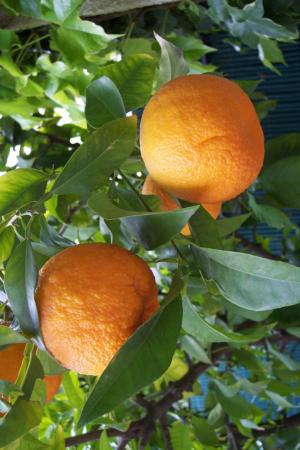Clementine tree
(Citrus x clementina)

Description
Citrus is a genus of flowering trees and shrubs in the rue family, Rutaceae. Plants in the genus produce citrus fruits, including important crops like oranges, lemons, grapefruit, pomelo and limes. The most recent research indicates an origin in the Himalayas. Previous research indicated an origin in the part of Southeast Asia bordered by Northeast India, Burma (Myanmar) and the Yunnan province of China, and it is in this region that some commercial species such as oranges, mandarins, and lemons originated. Citrus fruit has been cultivated in an ever-widening area since ancient times. It has also been cultivated for the production and consumption of citrus juice. These plants are large shrubs or small to moderate-sized trees, reaching 5–15 m (16–49 ft) tall, with spiny shoots and alternately arranged evergreen leaves with an entire margin. The flowers are solitary or in small corymbs, each flower 2–4 cm (0.79–1.57 in) diameter, with five (rarely four) white petals and numerous stamens; they are often very strongly scented. The fruit is a hesperidium, a specialised berry, globose to elongated, 4–30 cm (1.6–11.8 in) long and 4–20 cm (1.6–7.9 in) diameter, with a leathery rind or "peel" called a pericarp. The outermost layer of the pericarp is an "exocarp" called the flavedo, commonly referred to as the zest. The middle layer of the pericarp is the mesocarp, which in citrus fruits consists of the white, spongy "albedo", or "pith". The innermost layer of the pericarp is the endocarp. The segments are also called "liths", and the space inside each lith is a locule filled with juice vesicles, or "pulp". From the endocarp, string-like "hairs" extend into the locules, which provide nourishment to the fruit as it develops. Citrus fruits are notable for their fragrance, partly due to flavonoids and limonoids (which in turn are terpenes) contained in the rind, and most are juice-laden. The juice contains a high quantity of citric acid giving them their characteristic sharp flavour. The genus is commercially important as many species are cultivated for their fruit, which is eaten fresh, pressed for juice, or preserved in marmalades and pickles. They are also good sources of vitamin C and flavonoids. The content of vitamin C in the fruit depends on the species, variety and mode of cultivation. Fruits produced with organic agriculture have been shown to contain more vitamin C than those produced with conventional agriculture in the Algarve, but results depended on the species and cultivar. The flavonoids include various flavanones and flavones.
Taxonomic tree:







